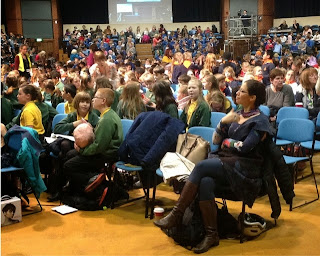Just some of the reactions I heard from the young attendees of the Animal and Plant Science Department's Annual Christmas Lecture. Over a thousand schoolchildren left inspired by the lecture and interactive demos, beating each other with their free posters and still grappling with the puzzle they had each been given to demonstrate the importance of practice.
The APS Christmas Lecture is modelled on the Royal Society Christmas Lectures, with the theme this year being 'Animal Academy': a showcase of the intellectual powers of our fellow creatures. I can't imagine that the Royal Society has nearly as much fun as we did though...or that they make half as much noise! The classes fairly raised the roof when Head of Department, Professor Michael T Silva-Jothy, did a quick roll call to make sure all the schools were present. Then the lights dimmed, the crowd hushed and the show was underway. First, we were introduced to the incredible problem solving abilities of the crow family, demonstrated wonderfully by Vera the Raven. Though only nine months old, she had already learnt how to ring a bell, pick up rubbish and even sort out the recycling in order to earn a food reward. But then -just as the lecture moved onto the powerful sense of smell that dogs have - the police invaded! Apparently, a thief was suscpeted in the audience...enter Black Labrador Rocco who quickly swept the room to find the stolen article.
 |
| The excitement builds in The Octagon as the children and teachers take their seats |
 |
| Police Dog Rocco searches the hall for the thief! |
For the grand finale, the children were instructed to open their mystery envelopes and retrieve their metal puzzles. A seemingly simple task - to separate the two interlocked pieces - but fiendishly difficult to accomplish! But on being shown the correct method, the children found that practice really could make perfect. And with that, the hall was once again invaded - this time by a marching samba band and a troop of circus performers keen to demonstrate just what humans are capable of learning with a bit of practice. I think the break dancing schools will be inundated with new recruits after the show we were treated to!
As the clapping died down, I had to zoom from my seat to get to my demonstration stall in time. A dozen or so different stands, all on the theme of 'Animal Intelligence', had been arranged outside the theatre to provide hands on activities for the kids. I was working with Duncan, Lucy and Camilla on the topic of songbirds, and in particular, how they learn their complex repertoires of songs. My fellow demonstrators had been inspired to construct a birdcage to surround our stall. Once inside, 'Alex the Friendly Parrot' would then play some recorded examples of birds that were taught to sing complex, human tunes and even mimic sounds as absurd as chainsaws and camera shutters. Whilst they were waiting to go inside, Camilla and I kept them entertained with a quiz on songbird facts - did you know that starlings can learn the songs of up to 22 different birds?!
 |
| Our stall ... featuring Alex the Parrot and the birdsong quiz |
As the kids came thick and fast, it was a good lesson in adapting science to suit the audience. With their hyper energy levels, hundreds of distractions and teachers trying to keep order, our messages had to be succinct and memorable to make an impact. It was a far cry from the staid conference hall, where the audience is expected to sit still and keep quiet, no matter how dry the lecture! But the cage and parrot proved a hit, although I'm not sure if some of the children thought Alex was a REAL parrot...for most though, the glasses were a giveaway!
The children may only have been there for just under three hours but a phenomenal amount of planning went into this event, involving dozens of volunteer students across the department. It was a showpiece for the power of science to inspire young minds and something that all universities should aspire to. For students, my advice is to throw yourself into it and get involved! ( you don't necessarily have to wear a parrot costume!) As for me, I am already looking forward to next year and wonder what the theme could be next...fantastic fish? Brilliant bacteria? Marvellous mushrooms? Who knows?! But I do know...I want to be there!
 |
| Meeting Vera... a very clever Raven! |

No comments:
Post a Comment
Note: only a member of this blog may post a comment.